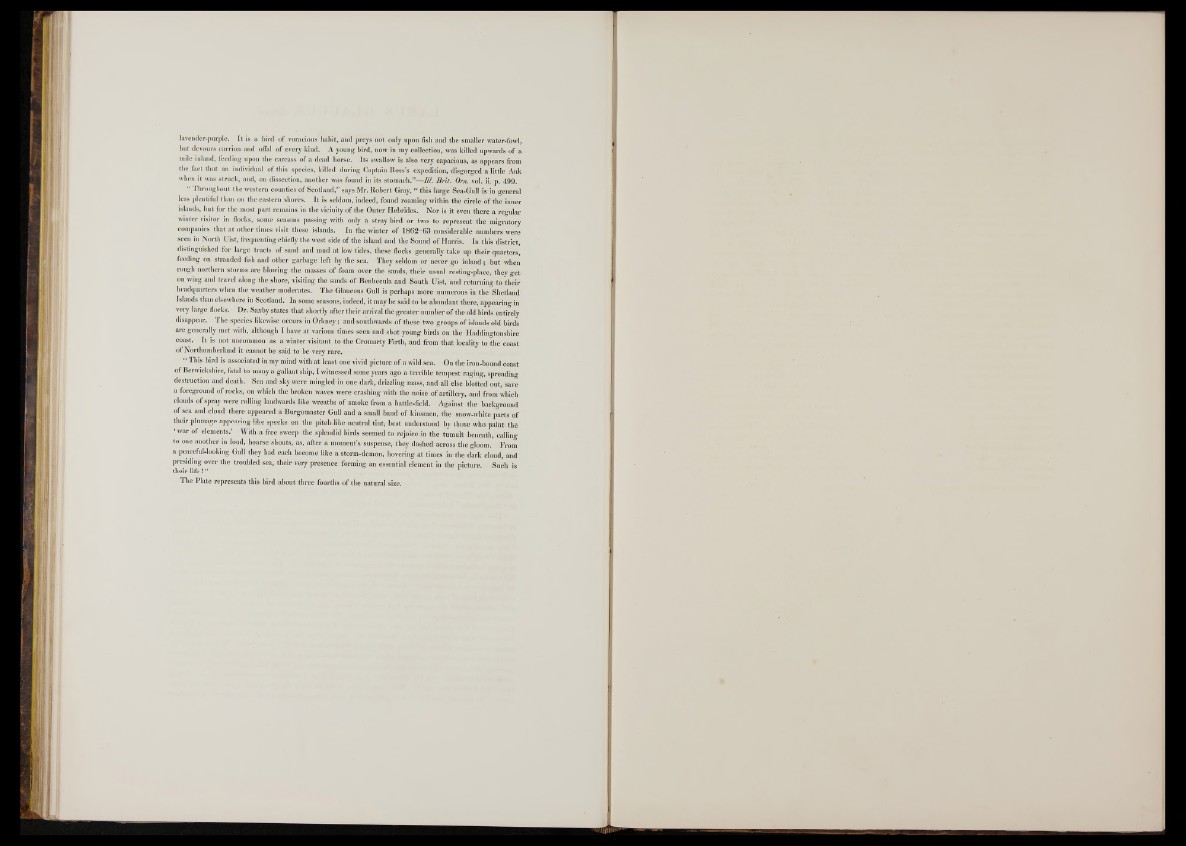
lavender-purple. It is a bird of voracious habit, and preys not only upon fish and the smaller water-fowl,
but devours carrion and offal o f every kind. A young bird, now in my collection, was killed upwards o f a
mile inland, feeding upon the carcass o f a dead horse. Its swallow is also very capacious, as appears from
the fact that an individual of this species, killed during Captain Ross’s expedition, disgorged a little Auk
when it was struck, and, on dissection, another was found in its stomach.”— III. B r it. Orn. vol. ii. p. 499.
“ Throughout the western counties o f Scotland,” says Mr. Robert Gray, “ this large Sea-Gull is in general
less plentiful than on the eastern shores. It is seldom, indeed, found roaming within the circle o f the inner
islands, but for the most part remains in the vicinity of the Outer Hebrides. Nor is it even there a regular
winter visitor in flocks, some seasons passing with only a stray bird or two to represent the migratory
companies that at other times visit these islands. In the winter o f 1862- 63 considerable numbers were
seen in North Uist, frequenting chiefly the west side o f the island and the Sound o f Harris. In this district,
distinguished for large tracts of sand and mud at low tides, these flocks generally take up their quarters,
feeding on stranded fish and other garbage left by the sea. They seldom or never go inland; but when
rough northern storms are blowing the masses o f foam over the sands, their usual resting-place, they get
on wing and travel along the shore, visiting the sands o f Benbecula and South Uist, and returning to their
headquarters when the weather moderates. The Glaucous Gull is perhaps more numerous in the Shetland
Islands than elsewhere in Scotland. In some seasons, indeed, it may be said to be abundant there, appearing in
very large flocks. Dr. Saxby states that shortly after their arrival the greater number o f the old birds entirely
disappear. The species likewise occurs in Orkney; and southwards o f these two groups o f islands old birds
are generally met with, although I have at various times seen and shot young birds on the Haddingtonshire
coast. It is not uncommon as a winter visitant to the Cromarty Firth, and from that locality to the coast
of Northumberland it cannot be said to he very rare.
I This bird is associated in my mind with at least one vivid picture o f a wild sea. On the iron-bound coast
of Berwickshire, fatal to many a gallant ship, I witnessed some years ago a terrible tempest raging, spreading
destruction and death. Sea and sky were mingled in one dark, drizzling mass, and all else blotted out, save
a foreground o f rocks, on which the broken waves were crashing with the noise o f artillery, and from which
clouds o f spray were rolling landwards like wreaths o f smoke from a battle-field. Against the background
o f sea and cloud there appeared a Burgomaster Gull and a small band o f kiusmen, the snow-white parts of
their plumage appearing like specks on the pitch-like neutral tint, best understood by those who paint the
‘ war of elements.’ With a free sweep the splendid birds seemed to rejoice in the tumult beneath, calling
to one another in loud, hoarse shouts, as, after a moment’s suspense, they dashed across the gloom. From
a peaceful-looking Gull they had each become like a storm-demon, hovering at times in the dark cloud, and
presiding over the troubled sea, their very presence forming an essential element in the picture. Such is
their life ! ”
The Plate represents this bird about three fourths o f the natural size.